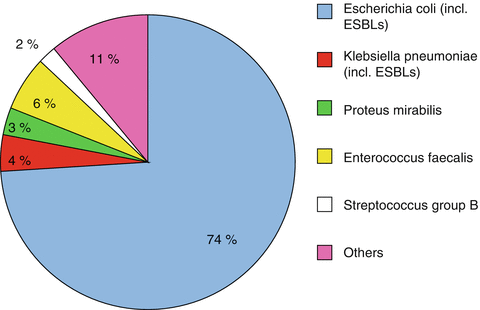and Christopher Isles2
(1)
Institute of Cardiovascular and Medical Sciences, University of Glasgow, Glasgow, UK
(2)
Dumfries and Galloway Royal Infirmary, Dumfries, UK
Q1 How does urinary tract infection present clinically?
Acute cystitis is the most common presentation. Elderly patients frequently present with asymptomatic bacteriuria. Acute pyelonephritis is suggested by the triad of fever with loin pain and loin tenderness. Acute prostatitis may cause pain or achiness in the abdomen above the pubic bone, in the lower back, in the perineum or testicles, in addition to symptoms of UTI. Urinary tract infection is an important cause of gram negative septicaemia in patients who are admitted to hospital. The full spectrum of presentations of urinary tract infection is shown the Box 31.1.
Box 31.1 Presentations of Urinary Tract Infection
Acute cystitis
Asymptomatic bacteriuria
Acute pyelonephritis.
Acute prostatitis.
Gram negative septicaemia.
Q2 Describe the typical clinical features of cystitis
These are one or more of sudden onset of frequency of micturition with urgency, a burning pain in the urethra when passing urine (dysuria), an intense desire to pass more urine after micturition (strangury), cloudy urine with an unpleasant smell, visible or non visible haematuria. Somewhat less typically cystitis may present with collapse, delirium, urinary retention, abdominal pain and agitation, particularly in the elderly.
Q3 What other causes of lower urinary tract symptoms do you know?
In females, it is probably best to consider these as being with or without vaginal discharge. Those with vaginal discharge include thrush, sexually transmitted disease, malignancy, physical irritation from IUDs and diaphragms and chemical irritation from latex condoms (latex free condoms are available). Some women present with frequency and dysuria but have no bacteria in their urine and no vaginal discharge, the so-called “urethral syndrome”. Possible explanations include bacteria that are difficult to culture, a chemical irritation to toiletries, symptoms relating to sexual intercourse and atrophic vaginitis. In men, by far the most common presentation in the absence of infection is that of prostatism presenting with frequency of urination, terminal dribbling, nocturia and hesitancy.
Q4 What other diagnoses should you consider in patients with loin pain?
An obstructing renal stone is the obvious answer. Pain will usually radiate from loin to groin and be associated with visible or non-visible haematuria. In all women of child bearing age with loin pain consider possibility of ectopic pregnancy and request a pregnancy test. In patients over 55 years of age with loin pain but no other symptoms of UTI consider acute abdominal aortic aneurysm and ask for an urgent surgical opinion.
Q5 Which bacteria are most likely to cause UTI?
E.coli derived from the gastrointestinal tract accounts for around 75 % of all infections. Other bacteria commonly causing community acquired UTI include klebsiella, proteus, enterococcus, streptococcus group B (Fig. 31.1). Proteus infections occur more commonly following instrumentation because they demonstrate an ability to swarm and cover surfaces. A greater variety of organisms and mixed infections occur in patients with catheters or stents and in those who are immunocompromised. Most infections ascend from the perineum to the bladder where they cause acute cystitis. Some then ascend further to the kidney causing acute pyelonephritis.


Fig. 31.1
Urinary pathogens in primary care in south west Scotland
Q6 Give five important predisposing factors to UTI.
Sexual intercourse may facilitate the transfer of bacteria from the perineum into the bladder. Foreign bodies such as a urethral catheter or ureteric stent are frequently associated with urinary tract infections. Atrophic vaginitis in post-menopausal women and poorly controlled diabetes can lead to loss of host defences. Any cause of urinary retention will allow urine, which is an excellent culture medium for bacteria, to stagnate in the bladder. Vesico-ureteric reflux is an important cause of ascending UTI in childhood. Failing to drink or void when busy on-call is common in conscientious female junior doctors (so called on-call cystitis). Risk factors for UTI are summarised in the box below.
Box 31.2 Risk Factors for Urinary Tract Infections
Sexual intercourse
Foreign bodies such as a urethral catheter or ureteric stent
Loss of host defences such as atrophic vaginitis or poorly controlled diabetes
Any cause of urinary retention.
Vesico-ureteric reflux
Q7 What is the role of the urine dipstick test in diagnosing urosepsis?
Urine dipstick tests detect leukocyte esterase and nitrites as surrogates for an elevated urinary white cell count and gram negative bacteriuria respectively. These tests are sensitive but not specific for urosepsis meaning that a negative result makes a urinary infection very unlikely but that a positive result does not confirm. The urine dip is therefore a rule out test.
Q8 Is it always necessary to culture urine before starting antibiotics for suspected UTI?
This depends on the circumstances. Urine culture is not necessary and not recommended by SIGN in an otherwise healthy woman presenting for the first time with acute cystitis, provided that the urine dipstick is positive for nitrites and leucocytes. The absence of both makes UTI extremely unlikely. All other patients i.e. those with recurrent infection, men, the elderly, the immunocompromised should have urine sent for culture before starting antibiotic (though it is not necessary to wait for the result of that culture before prescribing an antibiotic if the presentation is suggestive).




Q9 What is the correct way to obtain a mid-stream specimen of urine (MSU)?< div class='tao-gold-member'>Only gold members can continue reading. Log In or Register to continue
Stay updated, free articles. Join our Telegram channel

Full access? Get Clinical Tree








